The Face of God in the Transfiguration: Reflections on Lent Week II
by Borderland Nathan
Genesis 27:1-291)RSV-CE
1 When Isaac was old and his eyes were dim so that he could not see, he called Esau his older son, and said to him, “My son”; and he answered, “Here I am.” 2 He said, “Behold, I am old; I do not know the day of my death. 3 Now then, take your weapons, your quiver and your bow, and go out to the field, and hunt game for me, 4 and prepare for me savory food, such as I love, and bring it to me that I may eat; that I may bless you before I die.”
5 Now Rebekah was listening when Isaac spoke to his son Esau. So when Esau went to the field to hunt for game and bring it, 6 Rebekah said to her son Jacob, “I heard your father speak to your brother Esau, 7 ‘Bring me game, and prepare for me savory food, that I may eat it, and bless you before the Lord before I die.’ 8 Now therefore, my son, obey my word as I command you. 9 Go to the flock, and fetch me two good kids, that I may prepare from them savory food for your father, such as he loves; 10 and you shall bring it to your father to eat, so that he may bless you before he dies.” 11 But Jacob said to Rebekah his mother, “Behold, my brother Esau is a hairy man, and I am a smooth man. 12 Perhaps my father will feel me, and I shall seem to be mocking him, and bring a curse upon myself and not a blessing.” 13 His mother said to him, “Upon me be your curse, my son; only obey my word, and go, fetch them to me.” 14 So he went and took them and brought them to his mother; and his mother prepared savory food, such as his father loved. 15 Then Rebekah took the best garments of Esau her older son, which were with her in the house, and put them on Jacob her younger son; 16 and the skins of the kids she put upon his hands and upon the smooth part of his neck; 17 and she gave the savory food and the bread, which she had prepared, into the hand of her son Jacob.
18 So he went in to his father, and said, “My father”; and he said, “Here I am; who are you, my son?” 19 Jacob said to his father, “I am Esau your first-born. I have done as you told me; now sit up and eat of my game, that you may bless me.” 20 But Isaac said to his son, “How is it that you have found it so quickly, my son?” He answered, “Because the Lord your God granted me success.” 21 Then Isaac said to Jacob, “Come near, that I may feel you, my son, to know whether you are really my son Esau or not.” 22 So Jacob went near to Isaac his father, who felt him and said, “The voice is Jacob’s voice, but the hands are the hands of Esau.” 23 And he did not recognize him, because his hands were hairy like his brother Esau’s hands; so he blessed him. 24 He said, “Are you really my son Esau?” He answered, “I am.” 25 Then he said, “Bring it to me, that I may eat of my son’s game and bless you.” So he brought it to him, and he ate; and he brought him wine, and he drank. 26 Then his father Isaac said to him, “Come near and kiss me, my son.” 27 So he came near and kissed him; and he smelled the smell of his garments, and blessed him, and said,
“See, the smell of my son
is as the smell of a field which the Lord has blessed!
28 May God give you of the dew of heaven,
and of the fatness of the earth,
and plenty of grain and wine.
29 Let peoples serve you,
and nations bow down to you.
Be lord over your brothers,
and may your mother’s sons bow down to you.
Cursed be every one who curses you,
and blessed be every one who blesses you!”
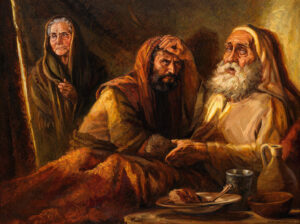
In these Old Testament readings from the Roman Breviary for today, Jacob used an act of deception to secure a permanent blessing from his father Isaac. Blessings in the Old Testament, such as the three part promise of God to Abraham, often had multiple fulfillments over the ages. As such, they were frequently cryptic, and had ambiguous parts that seemed to point past the person receiving it. Saint Cyril of Alexandria pointed out that the blessing had aspects that did not and could not refer to Isaac, such as the nations and peoples bowing down to him. The promise would extend out and refer to Jacob, Israel, Jesus, and Christians as the children of the promise.
Saint Cyril of Alexandria, 376 AD – 444 AD
“The content of the blessing would later be transferred upon Emmanuel himself. ‘Let nations serve you,’ it says, ‘and let rulers bow down to you, and be lord of your brother.’ Emmanuel was named ‘firstborn’ when he became one like ourselves, one who was ‘among many brothers.’ But not on this account should we forget that he is also God and Lord of all. We worship him as Master, and he has dominion as God over those called to be his brothers through grace.2)Cyril of Alexandria, Glaphyra on the Pentateuch, Volume I: Genesis, trans. Nicholas P. Lunn, The Fathers of the Church 137 (Washington, DC: Catholic University of America Press, 2018), 181.
“We, however, who are in Christ through faith, have been made rich in bread and wine. Israel does not share in these things, for such were not conferred by the blessings given to Esau. The poor Jews likewise do not share in the mystical blessing, since neither was this given under the ministration of the law. Rather, it was reserved for the people who are in Christ by faith. We, moreover, are at peace through Christ, while Israel is at war. We have inherited the land promised literally, which was a type of that which is spiritual and heavenly. This the Savior himself spoke of, saying, ‘Blessed are the meek, for they will inherit the earth.’ Also, we are included among the children of God through the Spirit of freedom. We are admitted to Christ as to one who is like us, a brother, and we perform a noble and willing obedience. Israel, on the other hand, was placed under a yoke, weighed down by the laws of Moses, suffering death as the punishment for transgressions. For Esau heard the words, ‘and you will serve your brother,’ that is, ‘you shall be made subject, unwillingly, to one whose nature is like yours.’”3)Ibid, 183.
Matthew 17:1-9
17 And after six days Jesus took with him Peter and James and John his brother, and led them up a high mountain apart. 2 And he was transfigured before them, and his face shone like the sun, and his garments became white as light. 3 And behold, there appeared to them Moses and Eli′jah, talking with him. 4 And Peter said to Jesus, “Lord, it is well that we are here; if you wish, I will make three booths here, one for you and one for Moses and one for Eli′jah.” 5 He was still speaking, when lo, a bright cloud overshadowed them, and a voice from the cloud said, “This is my beloved Son, with whom I am well pleased; listen to him.” 6 When the disciples heard this, they fell on their faces, and were filled with awe. 7 But Jesus came and touched them, saying, “Rise, and have no fear.” 8 And when they lifted up their eyes, they saw no one but Jesus only.
![]()
There is so much to write about the transfiguration, but I want to focus on a few things in line with the readings from Lent. The first is that Elijah and Moses are key figures of interest. Both of them fasted for 40 days; Elijah after receiving supernatural food and drink from an angel in 1 Kings 19, and Moses in Exodus 34 on Israel’s behalf after they sinned with the golden calf.
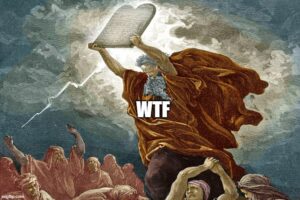
God was pissed. Really, really pissed. He was so pissed that he told Israel to go on ahead without him or he would torch their asses for being a “stiff-necked people.” But in one of the most beautiful exchanges of the Bible, Moses advocated on their behalf on the top of a mountain, he says he doesn’t even want to go to the promised land without God, and God relents because he “knows Moses by name.” And what does Moses want after being presumably so fearful and heartbroken? He wants to see God’s glory. God says that he cannot see his face, for no man can see him and live. He places him in a rock and passes by, shielding Moses from the fullness of the vision.
Elijah, likewise, after a period of spiritual dryness where he wants God to take his life because he is “no better than his fathers,” is sustained by and meets with God on a mountain. And God passes by him in a great wind, and then an earthquake, and finally a fire. But he is in none of these. Then comes a still, small voice, and Elijah wraps his face so that he will not see him and die.
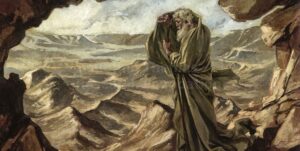
We have the law in Moses, and the prophets in Elijah. Both fasted for forty days after the sins of Israel, both met God on a mountain, and both desired to see God, even if in the case of Elijah it was simply to end his life. In both cases, they were unable to see God because no man could, and live.
But God never forgets a promise.
The True Face of God
Prior to this, Jewish interpretation often said that in these instances when the lucky few saw God, they didn’t view his essence, but rather a created glory or manifestation, or havod, or an intermediary, such as the Angel of the Lord. Ancient societies as well as Judaism had a concept known as “agency,” where a vassal would speak for, listen for, and respond as the person that had sent them. It can be seen in the Hebrew term shaliah (שָׁלִיחַ), meaning “one who is sent.”
Such contact with the Divine is a type, pointing forward to a greater fulfillment. When Jacob, the son of Isaac, wrestled with an angel and demanded a blessing, Saint Cyril pointed to this event and said that it was a type of a more perfect fulfillment in Christ.
Likewise, Christ in the Trinity was present and revealed the Father in all these Old Testament passages where the patriarchs desired to see God. Christ was there along with the Father and Spirit in the burning bush as well as on the mountain with Moses, and as the Son he was the Word of the Father. We do not come to the Father except through the son. There is even textual evidence in places like Jude 5, where the earliest and most reliable manuscripts say that Jesus “saved the people out of the land of Egypt.”4)Philipp F. Bartholomä, “Did Jesus Save the People out of Egypt? A Re-Examination of a Textual Problem in Jude 5,” Novum Testamentum 50, Fasc. 2 (2008), pp. 143-158. But the Trinitarian God, the person of the Son cannot be seen by mere human eyes until the incarnation as Jesus, and so the Angel of the Lord was still the created mouthpiece of the Divine.5)I recognize that the Eastern rite has a tradition that the Angel of the Lord is in fact the pre-incarnate Christ, but I follow with the thought of Saint Cyril of Alexandria about it being an angel, and he is an Eastern father that formed a good deal of our Trinitarian theology. My take I still believe does justice to the Eastern iconographic tradition while maintaining the philosophy of Augustine and Aquinas, as well as continuity with Jewish thought. I will revisit this topic in some depth at another time.
But now, God is man. And Jesus meets with his former friends, Elijah, and Moses, the one he knew by name. They get to see him face to face. All angels fall short to the glory of God, who is also the one receiver and the one who bestows the promise to Abraham, Isaac, and Jacob.
And like the first Isaac, who carried the wood up the mountain for his own sacrifice, Jesus carried his cross up the same mountain of Moriah. But unlike Isaac, who was spared because God himself would find a sacrifice, Jesus gave himself as the Passover lamb. Not even Isaac was the true beloved son; Jesus was proclaimed as such by the Father at his baptism. The true lamb, the true sacrifice, the true beloved son, the true face of God. No angels. No substitutes. No deception.
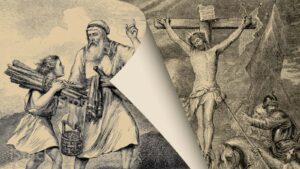
Liturgical Meaning
There are two things I will speak of, the feast of Tabernacles, or Booths, and the Bread of the Presence. The feast lasted 8 days, during which the Jews would set up many booths out of branches to dwell in for the duration, memorializing the 40 years of wandering in the desert. There was also an illumination festival at the Temple, where there was a torch procession, and enormous candelabra were set up in the Court of Women which would light up every courtyard in Jerusalem.6)George W. MacCrae, “The Meaning and Evolution of the Feast of Tabernacles,” Catholic Biblical Quarterly 22, no. 3 (July, 1960), 274.
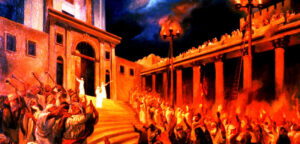
In the times of Israel, there was something called the “Bread of the Presence,” or more literally, the Bread of the Face. When Israel was in the desert, three things were kept in the Tabernacle: the Ark of the Covenant, the golden lampstand known as the Menorah, and the Bread of the Presence. These were signs that were patterned off heavenly realities that Moses saw in his vision of heaven. The Bread of the Face was a perpetual sacrificial offering that was renewed every Sabbath. Later around the time of the Temple, it was placed on a golden table in the Holy Place.
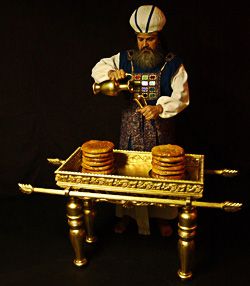
Three times a year, Jewish men were expected to travel to the Temple in Jerusalem: on Passover, Pentecost, and the feast of Tabernacles. These three times only, the priests would remove the golden table with the Bread of the Presence so that the Jewish pilgrims could view it. Both the Jerusalem and the Babylonian Talmud attest that the priests would lift it up before the pilgrims and say “Behold, God’s love for you!” This was to fulfill the commandment in Exodus 34:23, “Three times in the year shall all your males appear before the Lord God, the God of Israel.” Most translations say “appear before the Lord,” but many scholars have pointed out that the literal Hebrew says “see the face of the Lord.”7)Brant Pitre, Jesus and the Jewish Roots of the Eucharist: Unlocking the Secrets of the Last Supper (Doubleday: New York), 118-132.
During this feast of Tabernacles, Jewish men were going to see the bread of the face of God, with fiery lights exploding all over the Temple. Keep this background in mind when thinking of the true face of God, Jesus, showing his shining form to two holy men who had requested to see God’s glory so long ago.
Even now, we have the fulfillment of the bread of the presence in the Eucharist, the true face of our Lord. Unlike Isaac with his failing eyesight, and unlike spiritual children who see through a mirror, as though darkly, we see the face of our Lord with the eyes of faith, as we await his return.
1 Thessalonians 4:1-7
4 Finally, brethren, we beseech and exhort you in the Lord Jesus, that as you learned from us how you ought to live and to please God, just as you are doing, you do so more and more. 2 For you know what instructions we gave you through the Lord Jesus. 3 For this is the will of God, your sanctification: that you abstain from immorality; 4 that each one of you know how to control his own body in holiness and honor, 5 not in the passion of lust like heathen who do not know God; 6 that no man transgress, and wrong his brother in this matter, because the Lord is an avenger in all these things, as we solemnly forewarned you. 7 For God has not called us for uncleanness, but in holiness. 8 Therefore whoever disregards this, disregards not man but God, who gives his Holy Spirit to you.
Now we can look at the moral meaning of the Transfiguration, when taking into account the final New Testament reading for this Sunday. Saint Augustine said that in a spiritual sense, the white garments of Christ in the Transfiguration are his church.8)Augustine, Sermons on Selected Lessons of the New Testament, trans. R.G. MacMullen, ed. Philip Schaff, Nicene and Post-Nicene Fathers, First Series, vol. 6 (Buffalo, NY: Christian Literature Publishing Co., 1888), Sermon XXVIII. We are called to be a holy people, and moral purity is required of us. Moses was a man that kept God’s commandments even though Israel was largely destroyed in the desert due to their sin. Even he failed, and was unable to enter the promised land. Elijah also was a holy prophet. Christ is greater than both, and with his sanctifying grace we are called to an even great level of holiness than these Old Testament saints.
It is not an accident that this passage in 1 Thessalonians speaks mainly of sexual purity. Our lady of Fatima said, in the Church-approved vision, that “More souls go to Hell because of the sins of the flesh than for any other reason.” Saint Paul seems to be of the same mind, to the point that when speaking of abstinence from immorality he has mainly sexual immorality in mind. This tracks with my own experience in the modern age. Sex is everywhere, as is temptation. Like the holy men on the mountain, we take this Lent to fast for 40 days, because it gives us a powerful tool to deal with the lusts of the flesh. Remember that while Moses and Elijah were on the mountain and able to behold the face of God, most of Israel was not. Do not disqualify yourself from the race.

References
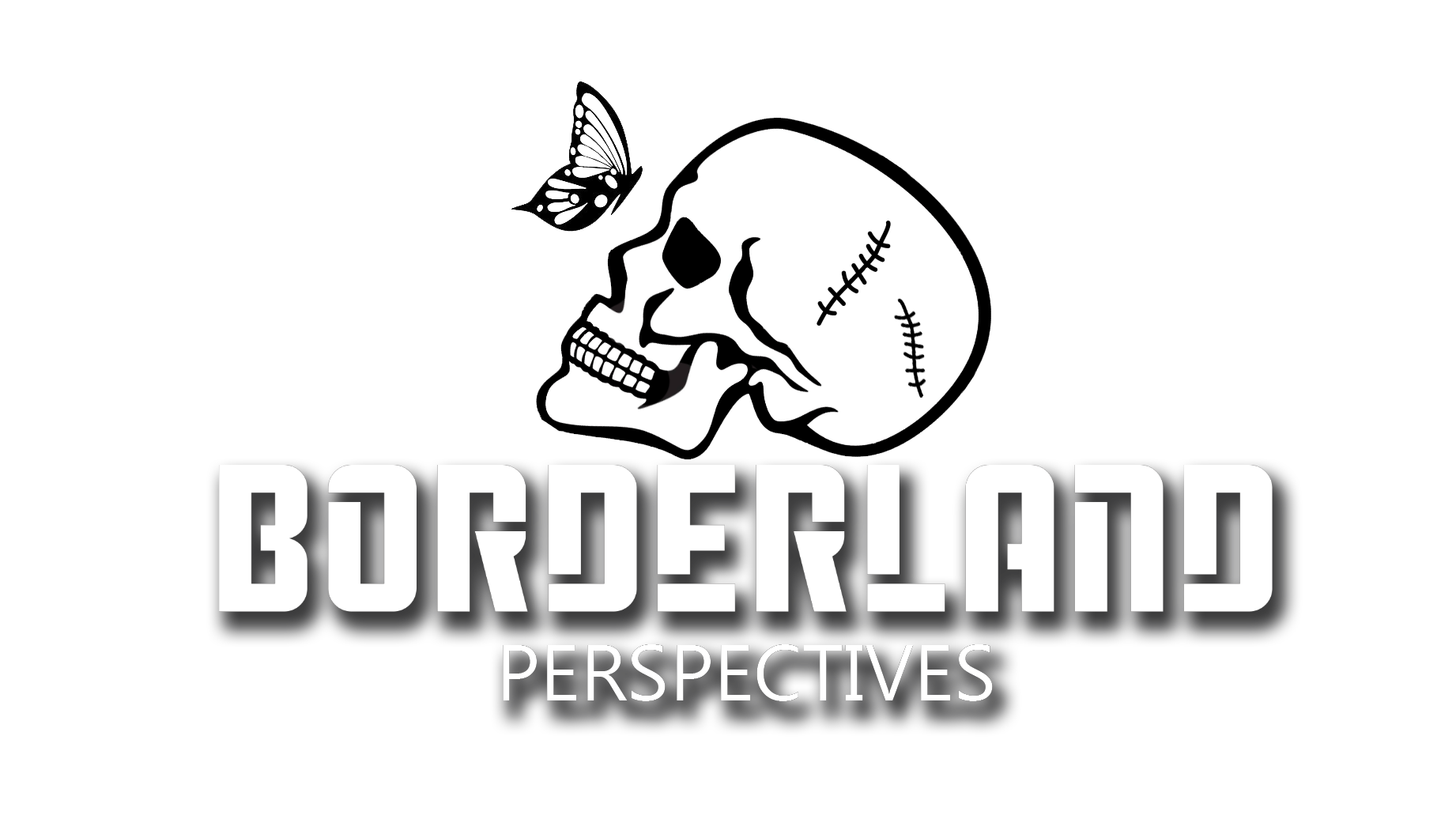

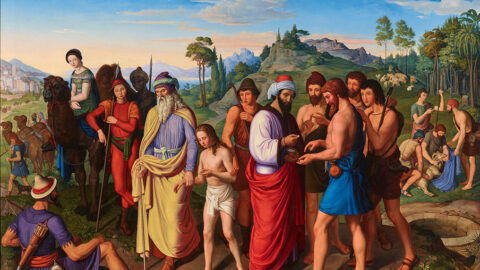
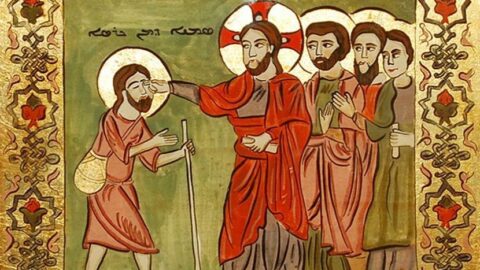
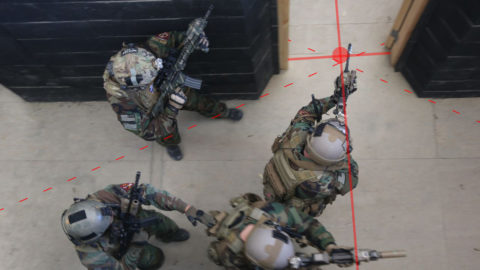
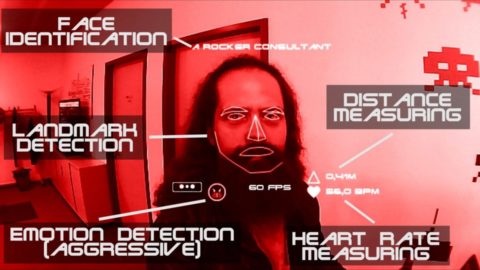
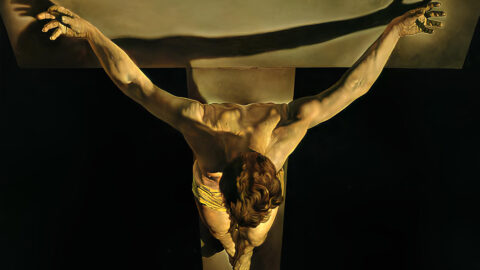

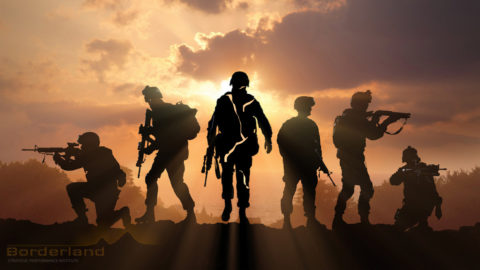
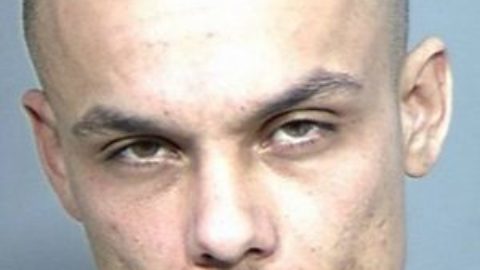
 Rob Brotzman
Rob Brotzman  Nathan Wagar
Nathan Wagar